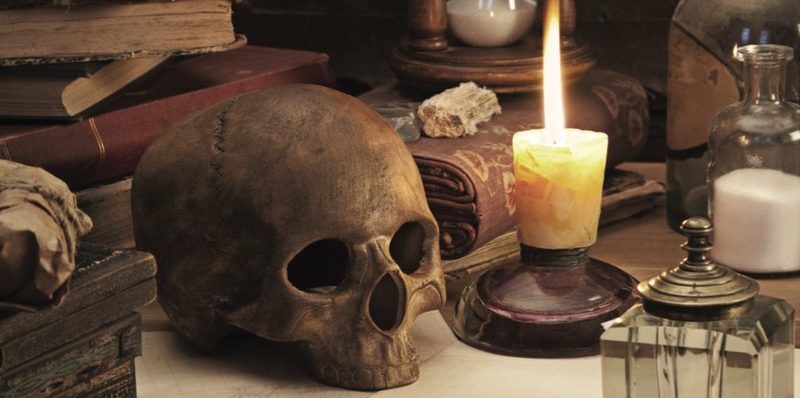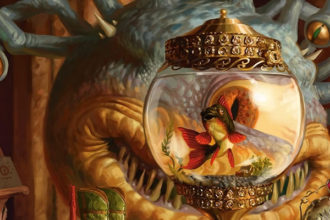The Artificer Class, Part Five

My text for today is a little unusual, in that I’m covering something from Tribality Publishing. One of our earliest and most successful releases is Rich Howard’s Alchemist class. It includes an Artificer tradition among its subclasses, so it belongs in this series. There are a lot of traditions for the alchemist, so I’ll try to cover all of them but there’s a chance it’ll stretch out to two articles.
Part Zero | Part One | Part Two | Part Three | Part Four | Part Five
The Alchemist Class
The class covers a lot of thematic ground, but in essence I’d say you could imagine a spectrum with the sorcerer on one end (spontaneous, internal magic) and the alchemist on the other (prepared, object-based), with the wizard in the middle of that range (prepared, pseudo-internal).
The core of the alchemist class:
- d8 Hit Dice – on par with rogues, as is often the case.
- No armor or shield proficiency; proficient in simple weapons, blowguns, hand crossbows, and nets. Oh, nets.
- Proficiency in alchemist’s supplies, and your choice of either herbalism kits or poisoner’s kits.
- Proficiency in Constitution and Intelligence saves. I love how this contrasts with wizards. It’s hard to make A Statement with saving throw proficiencies, but I think this hits that mark.
- Two skill proficiencies from a distinctly scholarly list.
- The flavor text on mixtures versus spells is important here, and it resembles (having come several years earlier) the flavor text of UA artificer spellcasting. Mixtures still function like spells in most mechanical ways (but see below). There are a lot of devices involved – “weapons, wands, orbs, rods, belts, amulets, and bizarre mechanical and mystic devices in addition to the potions, salves, and teas”. To elevate your characterization of an alchemist, lean as hard on this as your imagination and your group’s patience permit.
- The class uses the full-progression spell slot chart, but they don’t have 7th, 8th, or 9th level mixtures. Those slots serve as currency for other features, let them up-cast their 1st-6th level mixtures, or use your Tradition’s secret high-end formulas. (I love that the Traditions have exclusive access to the highest-level formulas.)
- Mixtures have the interesting ability to delay their effects after casting – including handing the item off to another character for activation. You can put a number of mixtures on delay equal to your proficiency modifier. In some campaigns I’d worry about players using this for healing potion snake oil scams. Outside of that use case, this opens up all kinds of interesting possibilities. Mixtures that you hand off use your spellcasting DC, while spell attack rolls use your proficiency bonus and the user’s Int modifier. Delayed mixtures lose their power when you take a long rest, at least.
- This all gets real messy when it comes to Concentration, because you’re still the “caster” of record for Concentration purposes. The potential for an ally to accidentally mess things up for you is huge. This comes off a bit awkwardly to me, but this is probably necessary for game balance.
- You have a formula book, and you gather formulas like a wizard gathers spells.
- No verbal components, ever, but you always have somatic and material components. Makes sense to me.
- You can look at a spell scroll and interpret it into a formula, if the spell also an alchemist formula for you.
- Magic items that require the sorcerer or wizard classes, or “any spellcaster,” are also open to alchemists. I think this is a particularly good catch on Rich’s part, and I need to hurry off to one of my works-in-progress and add a similar clause.
- You prepare and “cast” mixtures with the ritual tag even without having them prepared.
- Extend Supplies at 2nd level lets you make more of any given alchemical item, when you craft alchemical items in downtime. It starts at doubling your production, and advances to increasing it six-fold.
- At 3rd level, you pick a subclass, from the seven offered in this PDF.
- Ability Score Improvements show up at 4th, 8th, 12th, 16th, and 19th.
- Master Alchemist at 20th level lets you offload Concentration for mixtures to the person using the mixture – up to three at a time. This is a great feature; at worst, I wish it showed up a little earlier. Anything you do that changes Concentration changes a whole lot in 5e, though.
That’s the core of the class. As with any spellcaster, it’s hard to say anything useful about their spell list. On the whole, it’s light on direct damage and heavy on utility. Cure wounds is on the core list, but the rest of the spells I think of as healer essentials (lesser restoration and raise dead, mainly) show up in the Herbwarden Tradition’s bonus formulas.
There’s very little meat in the core class. Some classes say a lot in the core, others – like the warlock and wizard – save it all for the subclasses. I like what’s here so far. Cleverness is a-brewin’ in the nuances of how mixtures differ from spells.
Artificer
The Artificer Tradition emphasizes devices, whether “clockwork, electrical, or technomagical,” and the flavor text touches on a few ways you can bring this out in narration.
- Bonus Formulas are a big part of any Tradition, and as we’ll see, alchemists gain more formulas from their Bonus Formulas feature than most subclasses grant in spells from comparable features. Scaling up to 9th level helps! I especially like gate and time stop here, because I have such an easy time imagining those as devices. The spells here are almost exclusively utility effects, which is on-message for artificers.
- Artisan grants you three tool proficiencies.
- Jack of All Traditions at 6th level is approximately a bard’s Magical Secrets feature, but all at ance and for alchemists. You’re getting three formulas of 3rd level and below from the Bonus Formula lists of other Traditions – great to have, though a fairly narrow list.
- It is a little unusual to see a Magical Secrets-like feature attached to a spellbook class. When UA did that with the School of Theurgy wizards, it got a little hinky. At least there’s no default expectation that you can respend Spells Known when you level up that would cause Magical Secrets to break, as you have with bards.
- Arcane Expert at 10th level is 3.x’s Use Magic Device, but without the dice rolls. You can ignore class, race, and alignment restrictions on attuning magic items, except for legendary and artifact items. Also, you can decide to sustain mixtures that you’ve handed out, so that they don’t expire when you take a long rest – you just keep that spell slot tied up.
- I adore this feature for reaching back to the core magic-item-use functions of the 3.x artificer.
- Efficient Alchemy at 14th level lets you turn your 7th-level slots into (essentially) two 4th-level slots, which just have to be used for the same spell. If the mixture has a duration, you can’t overlap the durations. Once you gain an 8th-level slot, you can do the same with doubling a 5th-level mixture. The text calls out that these can be up-cast versions of lower-level spells, such as turning a 7th-level slot into two 4th-level cure wounds spells.
- Enduring Creations at 18th level lets you make magic items that last for 10 days, as long as they’re drawing on your bonus formulas. (That’s an absolutely critical limitation, and one that it’s easy to forget as you start to imagine applications.)
- Instantaneous effects get charges per day equal to your Int bonus.
- Effects that create objects end early if the object is destroyed.
- Concentration effects have some more complicated functions, but it amounts to letting you drop and resume Concentration as long as you do so willingly, rather than as the result of damage or becoming incapacitated.
- Linked gate reopens to the first designated location.
“Jack of All Traditions” is about as good a conceptual summary as we could want. Alchemists are already about having weird tricks up their sleeves. Every single one of these features just furthers that idea. You never know what an artificer might be able to do. The only thing I really miss from other iterations on the artificer is the battlesmith styling – armor, shield, and probably a heavily enchanted mace. But I’m not going to hold the writer’s feet to the fire for what he never promised in the first place!
Artificers are always complicated to play well, because there are (ha, ha) so many moving parts. I think this version strikes its balance convincingly. If you’re looking for a crafting class for crafters that centers 5e’s crafting system, you are in the wrong place. Keep in mind that this came out years and years before XGTE’s tweaks to the crafting system… and none of the official crafting systems have had any depth to speak of.
Herbwarden
This is a healing and nature-focused alchemist, as you might get from the name. Given that their “mixtures commonly take the form of teas, tinctures, salves, and tablets,” many of my friends would likely gravitate toward this subclass very strongly. Tea and witchcraft is a pretty big aesthetic, is what I’m saying.
- Their bonus formulas are a blend of healer functionality (lesser restoration, revivify, greater restoration, raise dead, heal, resurrection, power word heal, true resurrection) and druidic spells.
- Academic Medicine grants proficiency with herbalism kits and your choice of either Medicine or Nature. When you roll Medicine, you use Int rather than Wis. Good, functional skill feature – honestly, most subclasses aren’t complete without something that grants more proficiencies of one kind or another.
- Field Medicine lets you spend an action so that another character can spend a Hit Die to heal. A creature can be healed in this way once per short rest. The number of Hit Dice a target can spend scales up each time you gain a new subclass feature, to 5 HD at 18th If you have feats that improve how you use a healer’s kit, those explicitly apply to the amount healed.
- This pairs very appealingly with the Healer feat, to defray a lot of the mixture slot cost of being a primary healer.
- Apothecary at 6th level lets you get the same benefit out of an herbalist’s kit that the core class grants for alchemical supplies with the Extend Supplies feature. You also gain advantage on saving throws against poisons, and on saves that oozes, plants, and plant creatures force you to make.
- Nice to have; I’d consider expanding this to also grant resistance to poison.
- Master Chirurgeon at 10th level doubles your Int modifier for Int (Medicine) and Int (Nature) checks, and “when making healing mixtures from formulas such as cure wounds.” This is a little odd, though it was much less so when the PDF came out. Now, we’d expect much more strongly to see proficiency bonus doubled, rather than Int. I think the intent of the clause I’ve put in quotes above is to double your spellcasting modifier, when it applies to healing spells, but there’s not exactly a standard wording for that.
- Empower Patients at 14th level makes your patients better than they were before they got hurt or sick. They receive one free reroll of a saving throw before their next long rest, and can’t get this benefit again until they finish a long rest.
- It’s super hard to write compelling low-magic healing features that don’t cross into bigger, flashier magic. This is something my LARP-designing community has struggled with for literal decades. An extra boost in resilience is one of the common answers here, and I’m for it.
- Natural Ally at 18th level lets you turn a 9th-level spell slot into a shambling mound pet that you can communicate with telepathically. Getting to summon Swamp Thing is just so damn cool. That’s it, that’s my whole reaction.
The downside of the Herbwarden, much like the greenbond of Monte Cook’s Arcana Evolved that was so maligned in my gaming group, is that they’re hyper-focused on healing. Three of their seven features do nothing but improve your healing, so if you’re not excited about playing a healing healer who heals, go elsewhere. On the other hand, it’s a subclass, not a class. There are six other ways to play an alchemist!
Having said that, I love playing healers, and I am so here for this one. It’s a great way to present a non-curse-based witch. It winds up similar to the Circle of Dreams druid in some ways – a healing-focused spellcaster with druid spells – but the contrasts between the two keep them both interesting.
That’s it for this week. I’d love to finish this PDF in my usual level of detail in one article, but between the whole class and its many subclasses, that’s just not happening. I guess there will be another History of the Artificer article before I’m temporarily done! The Eberron hardcover has just been announced, so I’ll revisit this series once it’s released.



